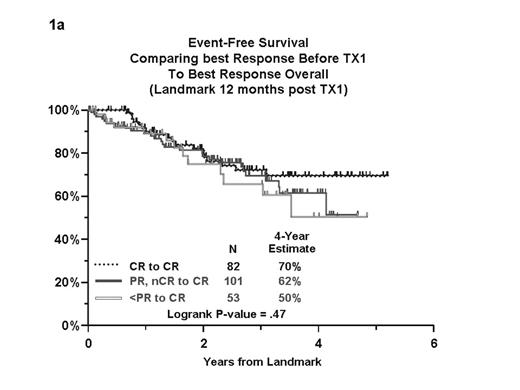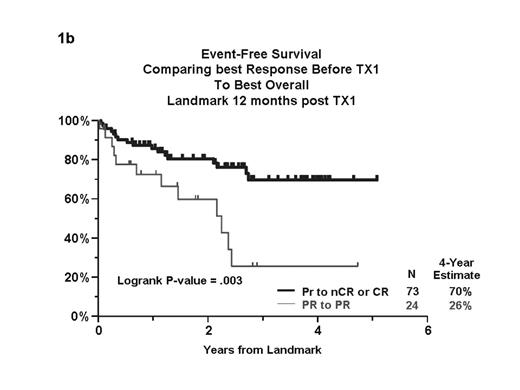Abstract
In acute leukemia and intermediate/high grade lymphoma it is important to achieve a CR as early as possible. The aim of the study was to evaluate if the same is true in myeloma treated with intensive therapy including tandem transplants (Tx-1; Tx-2). A total of 668 patients were enrolled on our Total Therapy 2 protocol, which randomized patients upfront to intensive therapy with or without thalidomide. The protocol consisted of 4 induction cycles followed by tandem transplants, 1 year of consolidation chemotherapy and maintenance therapy with dexamethasone pulsing every 3 months for 1 year and interferon-α, if tolerated. This study is limited to the 570 patients who received at least one transplant. CR was defined as absence of serum and urine M-protein with negative immunofixation electrophoresis and < 5% bone marrow plasma cells. EFS analyses were performed using Kaplan-Meier plots and log rank statistics to compare different groups. A 1 year landmark after Tx-1 was employed to compensate for guaranteed time of CR patients. Prior to Tx-1 89 patients (16%) were in CR, 111 in near CR (nCR), 110 in partial remission (PR) and 260 in < PR. After Tx-1, 170 (30%) achieved CR, 159 nCR, 116 PR and 125 < PR. The ultimate best response was CR in 319 patients (56%), nCR in 134, PR in 68 and < PR in 49. EFS of patients ultimately achieving CR was similar for those who were either in CR, nCR, PR or < PR prior to Tx-1 (p=0.47; Fig 1a). Patients in PR prior to Tx-1, but ultimately achieving CR or nCR faired considerably better than those who remained in PR (p=0.003 Fig 1b). Similarly, EFS of patients ultimately achieving CR was comparable for those who were either in CR, nCR, PR or < PR prior to Tx-2 (p=0.53). The same observations were made for both patients randomized to thalidomide or no thalidomide, or with and without baseline metaphase cytogenetics. With a median follow-up of 3 year after Tx-1 no difference in EFS was seen relative to the timing of achievement of CR. However, improvement of quality of response with further therapy resulted in a significant increase in EFS, strongly suggesting additional benefit from the second transplant and consolidation chemotherapy.
Event-Free Survival Comparing best Response Before TX1 To Best Response Overall (Landmark 12 months posts TX1)
Event-Free Survival Comparing best Response Before TX1 To Best Response Overall (Landmark 12 months posts TX1)
Event-Free Survival Comparing best Response Before TX1 To Best Overall Landmark 12 months posts TX1
Event-Free Survival Comparing best Response Before TX1 To Best Overall Landmark 12 months posts TX1
Author notes
Corresponding author



This feature is available to Subscribers Only
Sign In or Create an Account Close Modal